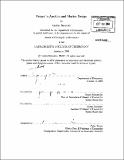| dc.contributor.advisor | Bengt Holmström and Sergei Izmalkov. | en_US |
| dc.contributor.author | Bremzen, Andrei, 1975- | en_US |
| dc.contributor.other | Massachusetts Institute of Technology. Dept. of Economics. | en_US |
| dc.date.accessioned | 2005-09-27T18:31:15Z | |
| dc.date.available | 2005-09-27T18:31:15Z | |
| dc.date.copyright | 2004 | en_US |
| dc.date.issued | 2004 | en_US |
| dc.identifier.uri | http://hdl.handle.net/1721.1/28819 | |
| dc.description | Thesis (Ph. D.)--Massachusetts Institute of Technology, Dept. of Economics, 2004. | en_US |
| dc.description | Includes bibliographical references. | en_US |
| dc.description.abstract | (cont.) the auctioneer are analyzed. | en_US |
| dc.description.abstract | This thesis consists of three essays in auction and market design. Chapter 1 studies sequential auctions with potential entry between rounds. In a simple model with two rounds, two initial bidders and one potential entrant, it is shown that every symmetric equilibrium first round bidding function must feature some degree of pooling. In one such equilibrium, the symmetric bidding function is a step function, reflecting the desire of present bidders to hide information from the potential entrant in order to deter entry. Extensions of the simple model to multiple incumbents and uncertain presence of the entrant are discussed. Chapter 2 studies the choice between two modes of trade: selling at a posted price or bargaining. It is shown that the choice of one of the regimes may serve as a signal of quality of the good, otherwise unobservable to buyers. The main result of this chapter is that both modes can coexist on the same market. This result holds both when sellers can choose the quality is given exogenously and when they can not. Chapter 3 examines origins of rules restricting the set of auction formats available to the seller in an auction. While wider set of possible auction formats available to the seller may increase his expected revenue, choice of one of the formats discloses seller's private information; the seller may want to commit to an auction format ex ante to avoid this disclosure. The value of commitment is analyzed in the context of announced versus hidden reservation value choice. A policy of conditional disclosure is introduced, which generates revenue higher than that generated by either of the unconditional policies. In the context of public procurement auctions, implications of expected and unexpected favoritism on the part of | en_US |
| dc.description.statementofresponsibility | by Andrei Bremzen. | en_US |
| dc.format.extent | 71 p. | en_US |
| dc.format.extent | 3851817 bytes | |
| dc.format.extent | 3858874 bytes | |
| dc.format.mimetype | application/pdf | |
| dc.format.mimetype | application/pdf | |
| dc.language.iso | en_US | |
| dc.publisher | Massachusetts Institute of Technology | en_US |
| dc.rights | M.I.T. theses are protected by copyright. They may be viewed from this source for any purpose, but reproduction or distribution in any format is prohibited without written permission. See provided URL for inquiries about permission. | en_US |
| dc.rights.uri | http://dspace.mit.edu/handle/1721.1/7582 | |
| dc.subject | Economics. | en_US |
| dc.title | Essays in auction and market design | en_US |
| dc.type | Thesis | en_US |
| dc.description.degree | Ph.D. | en_US |
| dc.contributor.department | Massachusetts Institute of Technology. Department of Economics | |
| dc.identifier.oclc | 60315714 | en_US |
